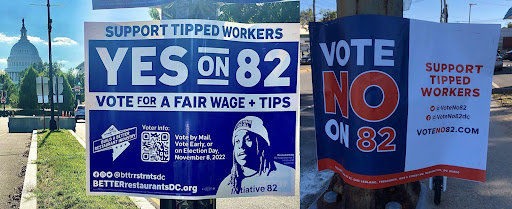The nation’s capital has the highest minimum wage in the country, but tipped workers still earn a sub-minimum wage, about one third of what other workers earn. That’s about to change, thanks to the determined efforts of tipped workers and their progressive allies, who brought the issue back to voters this election with Initiative 82.
The two-tiered minimum wage is a vestige of Jim Crow labor laws and continues to disproportionately hurt women of color, though big business lobbying groups like the National Restaurant Association have continued to defend it assiduously. Efforts to eliminate the sub-minimum wage in DC go back to 2015, when Initiative 76 would have raised the minimum wage to $15 per hour for all workers. But elected officials struck a deal to raise the minimum wage — while keeping the tipped wage in place — and the initiative was withdrawn. Supporters of one fair wage immediately responded with Initiative 77 to phase out the sub-minimum wage — and voters approved it in 2018, only to see the District Council overturn it. Rather than accept defeat, organizers prepared for another campaign. They won again at the ballot box this November, this time by an even greater margin.
After years of work, tipped workers and their supporters in Washington, DC appear to have finally won their fight to eliminate the sub-minimum wage. That means tipped workers will now earn the full minimum wage, plus tips. We sat down with Nikolas Schiller, an organizer on the Initiative 82 campaign who helped get Initiative 82 on the ballot and who has been involved in the fight to eliminate the sub-minimum wage since the first effort in 2015, to hear how they built grassroots support, won the support of elected officials, and countered the efforts of big business lobbyists.
What does the success of Initiative 82 mean for tipped workers, especially after the Council overturned a previous initiative? Will they respect the will of voters this time?
The landslide success of Initiative 82 and a majority progressive DC Council means there is very little chance Initiative 82 will be overturned next year.
When the DC Committee to Build a Better Restaurant Industry, the campaign committee behind Initiative 82, began collecting signatures for ballot access in October 2021, DC voters had signed petitions to eliminate the subminimum wage three times and were already quite educated about the issue. This time around, Initiative 82 went before voters on the General Election ballot and received even more support, nearly 74%, passed in all eight wards and every precinct.
Prior to the ballots being printed, Initiative 82 proposer Ryan O’Leary visited nearly every DC Councilmember’s office and reached out to the candidates who won their primary elections and asked them to sign a pledge to uphold the results. Nearly half of them signed the pledge, and we believe this is enough to stand against any effort to reverse the will of the voters.
How did the opposition respond to your efforts to get this back on the ballot, especially given that voters had already approved it once before?
Earlier in 2022, the opposition conducted their own polling and never released the results. This indicates that they knew for months that their effort to block the initiative was not going to be successful, and they ran a somewhat weaker campaign than in 2018. While they raised over $600,000 and spent nearly a third on a frivolous lawsuit hoping to knock the initiative off the ballot, we didn’t see the bulk of their funding get spent on traditional campaign items like posters,excessive direct mail, or poll workers. We assume they are going to lobby the DC Council to pass something that, while it doesn’t overturn Initiative 82, does something to weaken it (like delay implementation) or provides something to restaurants (like tax breaks).
Our red line is that the tip credit must be eliminated by 2027. Whatever help they want to give restaurants in the meantime to correct their flawed business models is okay with us as long as tipped workers are paid the same minimum wage as other workers by 2027.
What was the most effective message or tactic that the other side used? How did you combat it (or did you)?
In 2018, the opposition used the messaging “Save Our Tips” as their rallying cry. It presupposed the idea that customers would stop tipping once Initiative 77 passed. This time around, the opposition used two messages with voters. Neither worked very well.
The first was a direct plagiarization of our campaign’s message: “Support Tipped Workers.” Our campaign posters, which hit the streets in early August, and their campaign posters, which hit the streets in late September, both said “Support Tipped Workers” in large bold text. Thus voters would be supporting tipped workers no matter which way they voted. This copycat messaging is difficult to combat except by putting up more posters and by tweaking the message to simply say VOTE YES ON 82 on our second campaign poster.
The second most effective tactic employed by the opposition was to buttress the “Save Our Tips” messaging with the fear that businesses will use the service charge once Initiative 82 passes. Widely unpopular and confusing to consumers, the service charge is a fee tacked on to the end of a customer’s bill that began during the pandemic. Unlike tips, which are property of the employee, the service charge is property of the establishment, and they can divide up the fee however they see fit. 20% service charge could be divided up so the server gets only 10% and the establishment gets 10% used to pay other workers. Our campaign has been consistent with how we address this ridiculous scare tactic: raise menu prices gradually. A service charge does not need to be added to a bill if the menu prices reflect the true cost of the food and service.
Finally, in the last couple weeks leading up to the vote, the opposition was able to recruit a handful of servers and bartenders to be their flag bearers. The nature of the service industry prevented many tipped workers from outwardly supporting Initiative 82, so only the tipped workers who supported the status quo were heard. Tipped workers could face stealth repercussions for their support of Initiative 82 — from being scheduled fewer shifts to less lucrative shifts (lunch vs dinner) to being assigned smaller sections within the restaurant (fewer customers equals fewer tips), and sometimes even being terminated.
Yet in the end, ballots are secret, and thousands of current and former tipped workers chose to vote yes because their boss was not in the voting booth looking over their shoulder. Our poll of tipped workers showed 90% supported One Fair Wage policies, so we never doubted strong support among workers.
Did you think Initiative 82 was going to pass by as much as it did? What worked that you didn’t expect?
We went into this campaign with the belief that prior education and electoral efforts going back to 2016 had given us a strong majority base of support. Voter support likely improved with the pandemic because it exposed the tip credit system punishing tipped workers who sought unemployment compensation. We never doubted DC voters would cast a majority yes vote again on eliminating the subminimum wage.
The question was: how many percentage points will we win by? Eleven points, like last time? Or 20 points or higher? We did not expect to get 74% of the vote, a margin of nearly 50 points!
Our campaign was able to raise enough money to get on the ballot thanks to a generous contribution from the Open Society Policy Center, but after that, the direct funding mostly dried up. We did have $110,000 worth of fair trade, organic chocolate bars donated to us from Dr. Bronner’s as well as $31,000 in in-kind contributions by One Fair Wage, which included paying some of our legal bills. Those legal bills also zapped most of the get out the vote fund and left us with only enough to pay for campaign posters and stickers.
The campaign did not send direct mail to voters. Had the funding been there, we believe direct mail would have pushed the yes vote even higher by answering direct mail from the No on 82 camp.
We were pleasantly surprised by how popular the Dr. Bronner’s #YESon82 chocolate bars were with voters. We received the shipment with about two weeks left before Election Day and had volunteers spend hours affixing the stickers to the chocolate bars. We had races to see which volunteer could affix the stickers the fastest. We then put a call out within our network and the response was overwhelming. With Halloween just days away, a lot of kids ended up with some delicious chocolate with a prominent #YESon82 sticker

What did you learn through the campaign that we can use in the next phase to build progressive power for workers?
The two most important things the campaign learned were that funding needs to be lined up to ensure that ballot initiatives will cross the finish line and it is okay to let volunteer organizations help in the way they want to help. As has always been the case, coalition building is key to running a successful campaign.
The campaign would not have been nearly as successful had it not been for the organizing and volunteer energy provided by the local chapter of the Democratic Socialists of America. They knocked on over 18,000 doors to help secure the passage. In other campaigns we have worked on, it is the campaign itself that organizes this get out the vote effort, but in lieu of the campaign doing the organizing, it can be extremely helpful if other groups outside of the campaign take on the grassroots organizing. They were able to use our campaign to grow their organization.
Other groups played an important part in our coalition as well. DC for Democracy, Jews United for Justice, DC Jobs with Justice, the DC Labor Council, and the DC drag performer community came together in their own ways to support the grassroots organizing effort behind Initiative 82.
The important takeaway from this is that our campaign is temporary but volunteer organizations are not. Our allies like DSA were able to help grow their organizations and provide useful campaign experience that they will be able to deploy during the next election cycle. Strong coalition building leads to institutionalizing grassroots political power in a way that a single campaign (even a presidential campaign) does not. These types of campaigns also help build worker power, especially when workers benefiting from reforms are not members of organized labor unions with better established connections to elected lawmakers.

Volunteer canvassers from the Metro DSA Chapter in Ward 8

